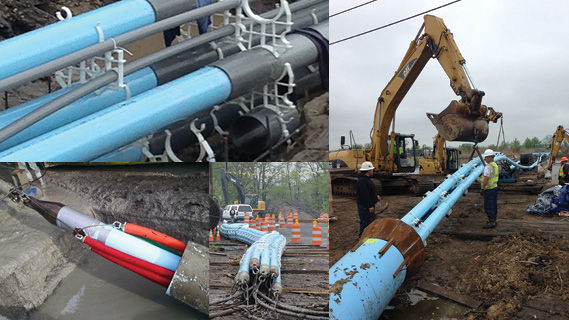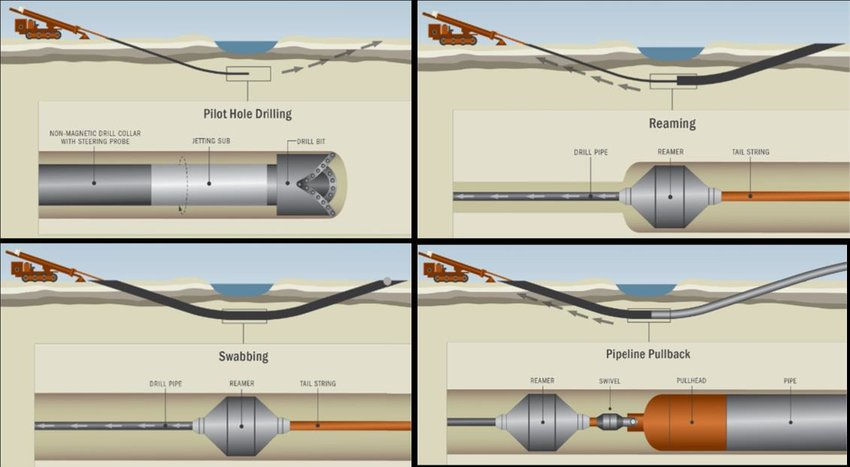Step-By-Step: How to Plan a Boring Pipe Conduit Installation Project
- Grid Tech
- Oct 18, 2023
- 5 min read
In the intricate dance of modern infrastructure development, one crucial but often overlooked step is the installation of boring pipe conduit wire systems. These underground pathways serve as the lifelines for electricity, data and more, ensuring our cities remain connected and powered.
However, planning a successful boring pipe conduit wire installation project is no walk in the park. It requires careful consideration of various factors, from the choice of boring method to environmental concerns and safety precautions.
Today, here in this comprehensive guide, we will take you through the essential steps of planning a boring pipe conduit installation project. Whether you are seasoned professional or a newcomer to the world of construction and infrastructure, this article will equip you with the knowledge required to embark on your project confidently. So, let’s dive into the intricacies of ensuring a smooth and efficient conduit installation from start to finish.

Step 1: Define Your Objectives and Scope
Before you can begin planning your boring pipe conduit wire installation project, it is essential to define your objectives and scope clearly. This process involves a meticulous examination of the project’s purpose, such as whether it serves electrical wiring, fiber optics or other utilities.
Equally important is determining the geographic area the conduit will cover. This meticulous scrutiny sets the tone for the entire project, establishing the parameters and direction for all subsequent planning and execution.
So, by gaining a clear understanding of your project’s goals, you lay the foundation for a well-organized, efficient and successful conduit installation that aligns precisely with your intended outcomes and requirements.
Step 2: Survey and Site Analysis
After defining your objectives and scope, the next critical phase is the comprehensive survey and site analysis. This process involves a meticulous examination of the terrain, assessing soil conditions, and identifying any pre-existing infrastructure that could impact your conduit installation. By gathering this crucial information, you'll be better equipped to make informed decisions about the most suitable boring method for your project. Additionally, this data aids in determining the optimal route for your conduit, ensuring that it not only meets your objectives but also navigates potential obstacles with efficiency and minimal disruption. A thorough site analysis is the key to a successful and hassle-free conduit installation.

Step 3: Choose the Right Boring Method
Choosing the right boring method is a pivotal decision in the project planning process, one that can significantly impact the success and efficiency of your conduit installation. Among the available options like Horizontal Directional Drilling (HDD), Microtunneling, and traditional trenching, each method presents a unique set of advantages and disadvantages. It's imperative to meticulously evaluate these factors against your project's specific requirements.
HDD, for instance, minimizes surface disruption, making it ideal for urban environments. Microtunneling offers pinpoint accuracy in tunnel placement. Traditional trenching may be cost-effective but can disrupt existing infrastructure. Therefore, your choice should align with the project's objectives, site conditions, and budget, ensuring a seamless conduit installation.
Step 4: Regulatory Compliance
Before advancing with your boring pipe conduit wire installation project, it is paramount to possess comprehensive knowledge of the local regulations and permits relevant to your endeavour. Strict adherence to environmental laws and safety standards is non-negotiable. Failing to comply can result in costly delays, legal complications, and potential harm to the environment. Therefore, it is imperative to engage in due diligence, securing all essential permits and approvals before commencing the project. This proactive approach not only ensures the legality of your actions but also fosters a responsible and ethical approach to construction, safeguarding both your project's success and the surrounding environment.

Step 5: Budgeting and Resource Allocation
Crafting a meticulous and comprehensive budget is a pivotal aspect of your boring pipe conduit installation project. It should encompass all facets, leaving no stone unturned, from labour and materials to equipment and contingencies. This budget serves as your financial roadmap, guiding you through the project's entirety. Effective resource allocation is essential to maintain control and prevent unexpected financial setbacks.
By efficiently distributing resources, you not only ensure the project's financial viability but also bolster its overall efficiency and success. This disciplined financial planning is a cornerstone of responsible project management, allowing you to navigate the complexities of conduit installation with confidence and fiscal prudence.
Step 6: Safety Precautions
Safety stands as an unwavering pinnacle in the hierarchy of construction priorities. Initiating a comprehensive safety plan is the cornerstone of responsible project management. It involves not only meticulous planning but also continual vigilance. Training your team to recognize and mitigate risks, along with providing them with the requisite protective gear, is not just a legal obligation but a moral imperative.
Regular safety inspections serve as a proactive measure to identify potential hazards and enforce adherence to safety protocols. This commitment to safety is paramount, as it not only safeguards your team's well-being but also fosters an environment where everyone can work confidently and thrive in the pursuit of successful conduit installations.
Step 7: Environmental Considerations
Environmental considerations must be a central focus in any conduit installation project, reflecting a commitment to sustainability and responsible stewardship. Implementing eco-friendly practices should be a guiding principle. These practices include minimizing soil disruption, controlling erosion, and mitigating any potential impact on local ecosystems.
By doing so, you not only demonstrate environmental responsibility but also proactively reduce the risk of legal complications. Responsible environmental practices not only align with regulatory requirements but also showcase a dedication to preserving the natural world for future generations.
Step 8: Project Timeline
Create a detailed project timeline with clear milestones and deadlines. Efficient project management ensures that your conduit installation stays on schedule and within budget.
Step 9: Quality Control
Implement rigorous quality control measures to ensure the integrity of your conduit installation. Regular inspections, testing, and adherence to industry standards are vital for long-term reliability.
Step 10: Post Installation Maintenance
After the conduit is installed, don't forget about post-installation maintenance. Develop a maintenance plan to address wear and tear, potential repairs, and upgrades as needed.

Conclusion
So, planning a boring pipe conduit wire installation project is a complex but essential endeavour for modern infrastructure development. It requires meticulous attention to detail, adherence to safety and environmental standards, and a commitment to quality. By following the step-by-step guide outlined in this article, you can embark on your project with confidence, knowing that you have considered all the crucial aspects, from defining your objectives to post-installation maintenance.
Remember that successful conduit installation not only ensures the seamless flow of utilities but also contributes to the sustainability and resilience of our cities. As you embark on your project, prioritize safety, compliance, and quality to create a lasting impact on your community's infrastructure. With the right planning and execution, your boring pipe conduit wire installation project can be a testament to excellence in construction and engineering.


Comments